News & Views
An Irish Atlantic Rainforest: A Personal Journey into the Magic of Rewilding by Eoghan Daltun
Peter Mabey reviews a new book which presents an inspiring example of individual action in the face of climate change
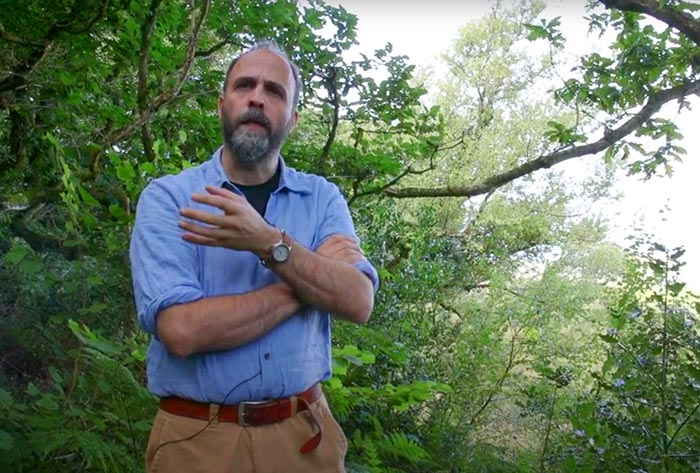
Eoghan Daltun in his rewilded forest in South West Ireland. Image: https://www.youtube.com/watch?v=zcx3Zp59R-c
This stimulating and wide-ranging book, numbering 300-plus pages, has one simple, underlying message: if we want to save the planet, leave nature alone. Without interference, natural landscapes and forests renew themselves perfectly well.
As the subtitle ‘A Personal Journey into the Magic of Rewilding’ indicates, this is an account of a project undertaken by Eoghan Daltun, who in 2009 bought 73 acres of land on the wild Beara Peninsula in South West Ireland, and restored it – or perhaps more accurately, allowed it to restore itself – into the environment it would naturally be; a temperate rainforest replete with ferns, fungi, mosses, wild flowers and flourishing native trees.
Daltun funded his purchase with the proceeds from an equally impressive project he undertook in his 20s. With some inheritance money, he bought an old, ruined house dating back to 1756 in Dublin, not far from Phoenix Park where the Dublin Zoo is located. Perhaps presciently, he describes waking on misty mornings to the sound of whooping monkeys, giving the surreal feeling of living in a rainforest. Dividing his time between Dublin and spells in Tuscany learning his trade as a restorer of stone sculptures – a profession he continues to practice – he rebuilt the house in a vernacular style more or less with his own hands, using whatever materials he could find. He did it so well that it is now listed as an example of traditional architecture by The Irish National Inventory of Architectural Heritage. He lived there for a while with his wife and two sons on his return from Italy, but the increasing urbanisation of the city coupled with his memories of walking in the forests of Tuscany and Poland gave him a yearning to live ‘somewhere more tranquil, with a close relationship to the natural world’ (p. 30).
The farm they subsequently bought in the Beara Peninsula was between the Atlantic coast and the mountains, and included an old farmhouse that was ruined and uninhabitable. The family rented nearby while it was restored and found the community very receptive to their plans; some of their neighbours became great friends, which Daltun describes as extremely important for the success of his project. My own interest in the book was sparked partly by the fact this area is only some 50 kilometres north from where I live in County Cork.
Much of the land was already forest, consisting of wild trees – sessile oak, downy birch, holly, willows, whitethorn, rowan, hazel, ash, alder and wild crab apple – fed by a network of streams which flowed through a rocky terrain of deep gorges, ravines and vertical escarpment faces. Most striking to Daltun on his first impression was the huge diversity of ferns and mosses:
Every surface of tree or rock exposed to rain was clad in thick, lush, spongy layers of mosses up to 12 centimetres deep, as well as a profusion of ferns and lichen… I had never before laid eyes on anything remotely like this wild, verdant and primeval landscape, and had no idea that such places existed anywhere in Europe, never mind in Ireland. It looked as though it belonged more in the tropical jungles of Costa Rica or Papual New Guinea than our wind-blasted island in the Atlantic. I was in complete awe of the place (p. 35).
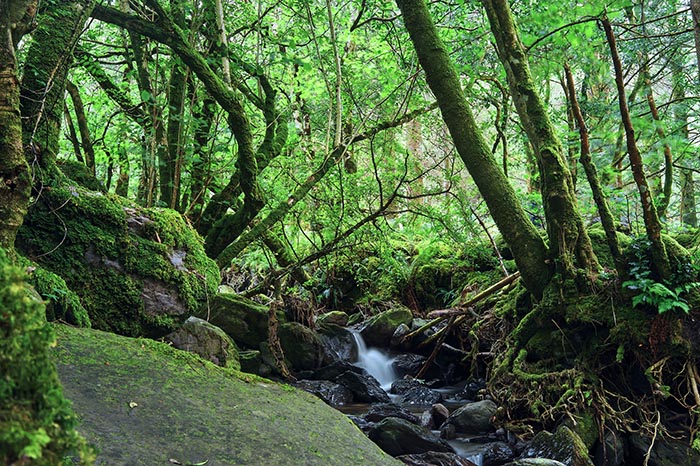
Irish forest. Image: Cavan Images [/] / Alamy Stock Photo
Avoiding an ‘Ecological Car Crash’
.
However, he soon discovered that this amazing environment was in deep trouble, being ‘browsed to death’ by feral goats, sika deer (introduced into Ireland from Japan 100 years earlier) and sheep. These herbivores feed on the nutritious shoots of new seedlings, preventing them from becoming established. The forest was therefore not regenerating itself, and bark stripping by goats and deer was damaging even the existing trees. Further obstacles to regrowth were escaped pheasants, and the incursion of non-native plant species, of which Daltun singles out rhododendrons (rhododendron ponticum) as having a particularly damaging effect. He calls them ‘a death sentence for any native woodland’ (p. 61) because their thick growth shades out all the native tree seedlings as well as the huge variety of other plants that normally flourish on the forest floor. These rhododendrons are extremely incursive and can be controlled only by constantly pulling them up, although even then their root system can poison the soil for years after their eradication.
Daltun found he was not alone in struggling with these issues. Ireland’s most important national parks such as Killarney and Uragh are suffering from exactly the same incursions, and globally, ‘invasive, non-native species are now recognised as being the second biggest driver of global species extinction, only barely pipped at the post by resource extraction like logging, hunting and fishing’ (p. 64).
He solved his own immediate problem, thanks to government grants, by fencing off 21 acres of land to prevent the overgrazing. This is not an ideal long-term solution, but it gave the land a chance to recover. The rhododendrons he dealt with by laboriously, and continuously, removing them by hand. The result was that in the following years he witnessed what he calls ‘the most stunning magical transformation of the land’:
Native tree seedlings began to pop up everywhere and, rather than immediately being eaten to death, were able to carry on growing into adolescence and beyond, giving rise to new young forests in areas that had previously just been grass. Where trees were already present, a rich dormant ground flora began to reawaken, with a great profusion of woodland flowers appearing, many of them species that I had presumed were completely absent… [producing] a rolling display lasting from late spring into early summer (p. 92).
He has since counted more than 100 species of wild flowers and 50 species of birds in the Bofickel Woods, not to mention innumerable varieties of insects, and in recent years has even noted the return of pine martens. But it was not until some years into the project that he realised, to his great surprise, that what he was restoring was not just a native forest but a rainforest. Not a tropical forest such as is found in South America and Southeast Asia, but a temperate rainforest [/]. This is a much rarer phenomenon, of which only a few other examples survive in places such as the coastal forests of British Columbia, the Valdivian forests of Chile and the Knysna-Tsitsikamma forests of South Africa.
The distinguishing feature of such a forest is the presence of epiphytes – non-parasitic plants such as mosses, lichens and ferns which grow on others without being rooted in the ground. They take their nourishment largely from airborne water, which is abundant in the Beara Peninsula where the humidity and precipitation, as well as the Gulf Stream, create a climate which is both mild and wet. In fact, Daltun discovered, the entire landscape would once have been clothed in such forests and would return to such a state if allowed to do so. He devotes several sections of the book to describing how, through clearance, colonisation and the impact of modern agri-business, Ireland has reached a state in which only a tiny fraction of its original forest remains. Daltun has described it as ‘one of the most ecologically dysfunctional places on the planet’ (see video at the end of the article).

Ferns and moss rooted in the branches of the trees are a characteristic feature of temperate rain forests. They are are not parasitic but take their nourishment from moisture in the air. Image: Urška Batistič [/] / Alamy Stock Photo
Wider Implications
.
This is a rich book which covers a huge range of topics alongside the central story and tackles many issues which have global significance. In his chapter ‘Fleeting Shadows’, for instance, Daltun discusses the positive role that animals can play in rewilding, touching upon the benefits of beavers, whom he calls ‘ecosystem engineers’ because when re-introduced they filter pollutants from rivers, encouraging native species to survive and having a positive effect on downstream flooding. He also gives an example of the success in Yellowstone National Park where grey wolves are keeping the deer population in check (see our article ‘Rewilding: A hope for the future’) and discusses whether the reintroduction of predators – in particular the lynx – into Ireland would be a feasible solution to the over-grazing.
In the chapter ‘More Complex Than We Can Think’ – a title drawn from a saying by the American plant ecologist Frank Egler: ‘Not only are ecosystems more complex than we think, they are more complex than we can think’ (p. 289) – he refers to the work of Suzanne Simard (see our review of her book Finding the Mother Tree), which has shown the symbiotic relationship between plants and underground mycorrhizal. He describes how this fungal network increases seedlings’ chances of survival fourfold, as not only do they help each other out but also communicate with each other, using chemical and electrical signals to pass on information in order to, for example, defend themselves against parasitic insect attacks. He quotes Simard, who when she was asked how we might apply ‘intelligence’ to trees and plants, replied:
Are there things we’re missing in plants because our concepts of intelligence are drawn from humans and animals? There could be whole ways of being we don’t even have words for (p. 290).
He is critical of many current conservation or restoration initiatives, arguing that often each group has its own narrow area of expertise, and therefore does not see the whole picture. He is especially sceptical of reforestation schemes which are based on new planting even when this consists of native trees. This is partly on the grounds of practicality, as self-seeded ‘wild’ trees adapt and germinate better and grow more vigorously than those planted; within six to seven years some seedlings at Bofickil reach up to five metres in height.
But more importantly, self-seeding introduces a much greater degree of biodiversity. At a time when we are undergoing a catastrophic loss of species globally, natural forests are crucial places of preservation, harbouring more than three-quarters of all terrestrial biodiversity (p. 163). But Daltun argues that too much emphasis is put on the number of species and not enough on variation within them.
While planted trees tend to be quite uniform genetically, and hence all look fairly similar in terms of overall shape, leaf size, colour… the very opposite is true of their wild equivalents. The oaks and other trees in the Bofickil… sites are all distinct individuals in every way; no two of them are alike (p. 46).
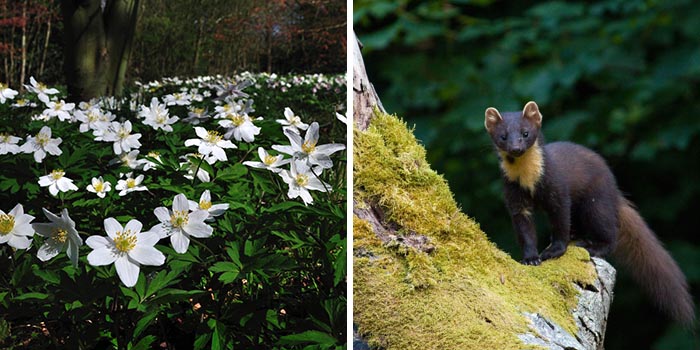
Returning species. Left: wood anenomes carpeting the forest floor (image: Colin Varndell [/] / Alamy Stock Photo). Right: the pine marten, native to Ireland but now very rare (image: Enda Flynn [/] / Alamy Stock Photo)
The Magic of the Wild
.
The book is, as its title suggests, very much an account of Daltun’s personal journey, and it is interspersed with stories about his family and neighbours as well as his travels in other parts of the world. He pays a visit to the Knysna-Tsitsikamma forest in South Africa, for instance. Some of the most moving passages of the book describe his own deep pleasure at being in forest environments:
There is true liberation and healing in forsaking the worry and discord of the human sphere for a while, before engaging with renewed energy, and clarity around what really matters and what doesn’t. […] After spending time in the woods, I leave as a different person, recharged to my very core. All is once again right with the world. These feelings, a combination of deep joy, serenity and hope, have never lessened over time… In moments, it goes beyond meditation, to the closest I have come to what might be described as a transcendental experience (p. 86).
Because of the enormous benefits of this ‘forest bathing’, he opens his own woods to the public and has set up trips for school kids around the land, giving talks on biodiversity, photosynthesis etc., in the hope of bringing his ideas to a younger age group. However, he has found the kids are largely interested in getting muddy, and collecting insects and leaves in jars and examining their finds! At a time when we are all too familiar with the obsession with screens and phones – and not to deny the usefulness of these means of communication – there is a sense that this distancing from reality cannot be a substitute for direct experience of the natural world.
The power of the book lies in the fact that Daltun does not just write about the rewilding or the importance of our natural forest, but demonstrates by his actions what can be achieved, although some readers may be disappointed if they are looking for a ‘how to’ handbook. It could be said that in some ways the book falls between two stools: not enough scientific detail on the one hand, and on the other an over-emphasis on humankind’s wanton destruction on the earth. On the latter, there is no doubt about the depth of Daltun’s feelings. In his chapter ‘The Red Pill’ – lovers of The Matrix will grasp the reference – he speaks about the ‘searing existential pain’ that ecological awareness can bring. ‘To truly appreciate just how astonishingly beautiful, complex and precious something approaching real wild nature is makes it impossible not to see the present and increasing lifelessness of the land practically everywhere you look’ (p. 172).
He references the examples of the fight of indigenous people in places like the Amazon Rainforest – often better publicised than forests closer to home – bringing to mind the Cree Nation quote: ‘Only when the last tree has died and the last river been poisoned and the last fish been caught will we realise we can’t eat money.’
However, in his best writing, Daltun conveys his passion and enthusiasm for what he has achieved over fifteen years while on his ‘personal journey’ and I myself find much of what he has to say about ‘the magic of rewilding’ to be inspiring. It is certainly a book which deserves our attention, at the very least because of the critical issues it raises. As Daltun puts it:
The Bofickil woods […] pose an ever more urgent and vital question, encapsulating what is probably the greatest challenge of our time: how can we achieve a paradigm shift away from the past and present situation, in which only either nature or people do well, towards a future in which both are able to survive, and indeed, thrive, together? (p. 151)
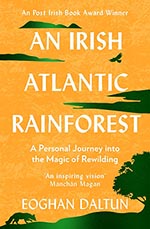 An Irish Atlantic Rainforest was first published in Ireland by Hachette Books, Ireland in 2022, and is now available in paperback (Hachette Books Ireland, 2024).
An Irish Atlantic Rainforest was first published in Ireland by Hachette Books, Ireland in 2022, and is now available in paperback (Hachette Books Ireland, 2024).
This video gives more information and a glimpse of the forest:
Peter Mabey MRIAI
is an architect, sculptor and painter, living in South West Ireland. He is also a long-term student of the Beshara School. He has completed woodsman and stone walling courses and consulted on projects on the Chisholme Estate in The Scottish Borders.
read more in beshara magazine
Rewilding: A Hope for the Future
In the light of the recent UN report on the radical decline of biodiversity, Richard Twinch investigates a movement which promises to restore ecological harmony
Review: Finding the Mother Tree
David Hyams reviews Suzanne Simard’s book about the intelligence and cooperative behaviour of trees
More News & Views
Don’t Take It Easy
Richard Gault is inspired by Michael Easter’s book The Comfort Crisis and explores the idea of ‘misogi’ during a 600-mile walk across Scotland
Book Review: ‘The Serviceberry’
Martha Cass contemplates the message of a new book by Robin Wall Kimmerer that advocates ‘an economy of gifts and abundance’
Book Review: ‘Conversations with Dostoevsky’
Andrew Watson engages with an innovative new book by George Pattison which explores Dostoevsky’s relevance in the contemporary world
Thich Nhat Hanh & the Poetry of Engaged Buddhism
Philip Brown presents the poem ‘Recommendation’ and comments on the potential of contemplative art to foster compassion
Introducing… ‘Perfect Days’ and ‘Nowhere Special’
Jane Clark watches two films with a contemplative theme
Book Review: ‘Irreducible: Consciousness, Life, Computers and Human Nature’
Richard Gault reviews a new book by Federico Faggin, one of the leading lights of the science of consciousness
FOLLOW AND LIKE US
——————————————
——————————————
——————————————
If you enjoyed reading this article
Please leave a comment below.
Please also consider making a donation to support the work of Beshara Magazine. The magazine relies entirely on voluntary support. Donations received through this website go towards editorial expenses, eg. image rights, travel expenses, and website maintenance and development costs.
READERS’ COMMENTS
4 Comments
Submit a Comment
FOLLOW AND LIKE US
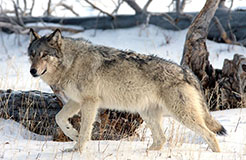
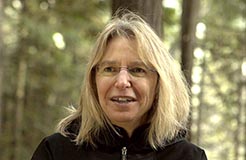
An inspiring review but you don’t need to go to Canada or South Africa to explore other temperate rainforests. There are many scattered around north-west Europe’s coasts, so also in Cornwall, Wales, Cumbria and Scotland (hence a name for such forests is Celtic Rainforest). I discovered one in Argyll during my walk along Scotland two years ago. I was enchanted by the fern sprouting trees. That’s where I learned what an epiphyte is.
Thanks for the positive story and the seeds of inspiration. Fences can obviously help a lot to get the forests back. Better to be simple rather than too scientific as then most people can feel that it’s possible for them also to do similar. The science can after for students to study firsthand the ecologic dynamics and help to validate such work. Regards Peter Webb
The Restoration, or rejuvenation, or even The Redemption of Bofickel Forest comes to me as a balm. Perhaps I’ve a better ear for such, now coming into my seventh decade, and now recovering from open heart surgery (and now absorbing a competently-written scenario describing the opening hours of a nuclear exchange) (a book lent by a friend for recovery reading); but,
Suddenly I can think of nothing more important that redeeming a forest to some primeval state, or returning my own 7,500 sq ft city lot here in Illinois, just up the hill from the Mississippi River, to its gentler state of existence of a hundred years ago when my humble bungalow was first built.
Your coverage of this work here is like a gentle breath and a balm. Please sign me up for more. Thanks.
Tim Long
Brilliant project in Ireland. Well Done. We are tryung very hard to stop Warwickshire Wildlife Trust from felling trees in an Ancient Forest near Coventry called Piles Coppice. ( a remnant of the Forest of Arden) I will be buying your book soundz inslirational.